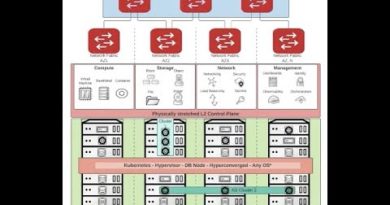Web App Pentesting – HTTP Headers & Methods
Welcome to the all-new, revamped Web App Pentesting course, in this video, I explain the various HTTP request and response headers as well as HTTP methods and how the PUT method can be abused.
Get started with Intigriti: https://go.intigriti.com/hackersploit
//PLATFORMS
BLOG ►► https://bit.ly/3qjvSjK
FORUM ►► https://bit.ly/39r2kcY
ACADEMY ►► https://bit.ly/39CuORr
//SOCIAL NETWORKS
TWITTER ►► https://bit.ly/3sNKXfq
DISCORD ►► https://bit.ly/3hkIDsK
INSTAGRAM ►► https://bit.ly/3sP1Syh
LINKEDIN ►► https://bit.ly/360qwlN
PATREON ►► https://bit.ly/365iDLK
MERCHANDISE ►► https://bit.ly/3c2jDEn
//BOOKS
Privilege Escalation Techniques ►► https://amzn.to/3ylCl33
Docker Security Essentials (FREE) ►► https://bit.ly/3pDcFuA
//SUPPORT THE CHANNEL
NordVPN Affiliate Link (73% Off) ►► https://bit.ly/3DEPbu5
Get $100 In Free Linode Credit ►► https://bit.ly/3yagvix
//CYBERTALK PODCAST
Spotify ►► https://spoti.fi/3lP65jv
Apple Podcasts ►► https://apple.co/3GsIPQo
//WE VALUE YOUR FEEDBACK
We hope you enjoyed the video and found value in the content. We value your feedback, If you have any questions or suggestions feel free to post them in the comments section or contact us directly via our social platforms.
//THANK YOU!
Thanks for watching!
Благодарю за просмотр!
Kiitos katsomisesta
Danke fürs Zuschauen!
感谢您观看
Merci d’avoir regardé
Obrigado por assistir
دیکھنے کے لیے شکریہ
देखने के लिए धन्यवाद
Grazie per la visione
Gracias por ver
شكرا للمشاهدة
———————————————————————————–
#Pentesting#Cybersecurity
by HackerSploit
linux http server




Thank you so much
HI. thanks for you great contents. It's really helpful to understand the procedure. Such a question, can you use ZAP for the above reason? Thank you!
you are the best sir
Love your content, your bootcamp series is gold!
What an outstanding video. Perfectly explained buddy great job
Unveiling the Power of HTTP Headers & Methods: Enhancing Web Application Security
In the ever-evolving landscape of web application security, a profound understanding of HTTP headers and methods is essential for safeguarding against potential vulnerabilities. This article sheds light on the significance of HTTP headers and methods, offering insights into how they contribute to fortifying web application security.
HTTP Headers: Guardians of Communication (H2)
Introduction to Headers (H3): HTTP headers are vital components of the communication between a client (browser) and a server. They convey crucial information about the request and response, enabling browsers and servers to exchange data effectively.
Common Types of Headers (H3):
Request Headers: Sent by the client to the server to provide additional information about the request. Examples include the User-Agent, Accept, and Referer headers.
Response Headers: Sent by the server to the client to provide information about the server and its response. Examples include the Server, Content-Type, and Set-Cookie headers.
Security Headers: Enhance web application security by mitigating potential threats. Examples include the Content-Security-Policy, X-XSS-Protection, and Strict-Transport-Security headers.
HTTP Methods: Initiating Actions (H2)
Understanding Methods (H3): HTTP methods, also known as verbs, define the action to be performed on a resource identified by a URL. They dictate how a server should process the request.
Common HTTP Methods (H3):
GET: Retrieve data from the server. It should not have any side effects on the server.
POST: Submit data to be processed by the resource identified in the URL. It may result in changes on the server.
PUT: Update a resource or create it if it does not exist.
DELETE: Remove a resource from the server.
PATCH: Apply partial modifications to a resource.
Security Implications (H2)
Security Enhancements (H3): Proper usage of headers and methods can significantly enhance web application security.
Content Security (H3): Security headers like Content-Security-Policy (CSP) can prevent cross-site scripting (XSS) attacks by restricting the sources from which content can be loaded.
Protection Against CSRF (H3): Implementing the appropriate HTTP methods (such as POST) for actions that modify data can help mitigate Cross-Site Request Forgery (CSRF) attacks.
Web App Security and Beyond (H2)
Security Auditing (H3): During security audits and penetration testing, professionals scrutinize HTTP headers and methods to identify potential vulnerabilities.
Testing Scenarios (H3):
Header Analysis: Evaluate the presence and configuration of security headers to ensure proper protection against common attacks.
Method Testing: Assess the application's behavior in response to various HTTP methods to detect any unexpected side effects.
Elevating Web App Security (H2)
Best Practices (H3):
Implement Security Headers: Incorporate security headers like CSP, X-Content-Type-Options, and X-Frame-Options to enhance security.
Use Appropriate Methods: Use the correct HTTP methods for actions based on their intended purpose.
As you delve into the realm of HTTP headers and methods to bolster web application security, Gildware Technologies, a leading provider of innovative software solutions, is your partner in ensuring the highest standards of security and performance.
Access Now: https://gildwaretechnologies.com
great job with the video
this was an awesome video
can we have your terminal config?
thanks for the video, could you let me know what software are you using to record and what microphone?
Thank You
so if i use -X "PUT" and upload the same file, will it overwrite the data?? and if I use -X "POST", it will create new data on server, if I make same request multiple times??? AM I CORRECT???
Thanks! Great way of explaining and showing things! 😉
Thank you, here's my like and sub 🙂
Thank you Hackersploit! This is an eye-opener! A curl can be considered as a Passive or Active Recon?
Thank you for in-depth explanations on each component, it’s very useful and informative.
A great learning video,,,keep going
That was really informational video and has given me a new insight and introduced me to a what I would like to call as "HTTP methods vulnerability" because it can actually allow to upload and delete files etc to a web server given if its not protected…THANKS ALOT
Great video for Newbies exceptional teaching Sir please make more such videos
Sir!, is there any way to upload php files via PUT method directly from burp?
If so, then how to add the php bkdoor file directory in the http request section?
Again, Thank you sir for this video. I was much in need of it.🔥
great video sir , i am bigner i learned lots of things in this video, this series is going to one of the my favourite , again tqu for this series sir
how to upload file using POST method?
Alexis thanks a million. You’re indeed God sent. You method of teaching makes even a 5 year old understand. Thanks again🙏🏾🙏🏾🙏🏾
another great video. Well researched and clear in the explanation.
Thank you so much!!!!
Useful information, thank you 🙏
Thanks, man.
thanks for making the content o/
Great video, thank you for your time.
Sir, please upload video on web app pentesting daily… Please 🙏🙏🙏🙏🙏🙏
Another one great video, thanks a lot for it
Please keep this going…
that is really helpfull at a right time, I am literally expectiing this from you SIR
you sir are truly great. I am learning so much from you.
Great material ! Really helpful for beginners 🙂 Thank you
Always enjoy the content you put out; keep it up good sir 👍
You are the reason we're still breathing Alexis✌️
Thank you. God Bless You ❤️
keep em coming, I'm also looking forward to the next hacker simulator video
Thanks a lot
Really liked the video. But can you tell me your Desktop Environment Name And The terminal Name..
Great,, I really loved the demonstration of delete method to delete the pho backdoor,, keep it up
Sir Your content are very helpful for us !!!
Thank You Sir 🙂
Thank you❤
Amazing explanation bhayia
Thanks alot for all the great lessons you are given out, it really putting some of us on the right channel…..
Amazing Job (: , Keep It Up
Hi, im stuck in this scenario where i got FTP connection as anonymous login/password but im unable to run files or modify files on the system the server does have port 80 open but it says there is no page on it.What can i do to run file or modify or get privilege escalation
u talk way too much just do it and explain as you do it!
The way you explain
things is . . Speechless .
We understand everything like a piece of cake. Much appreciated. 👏
Nice